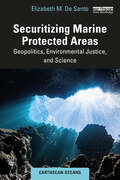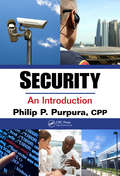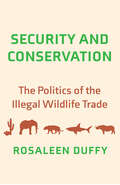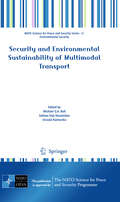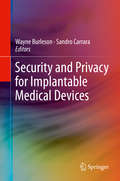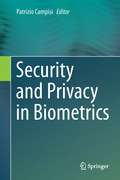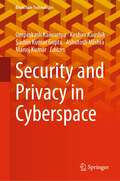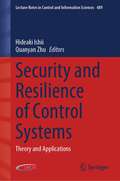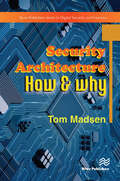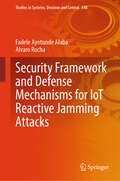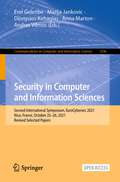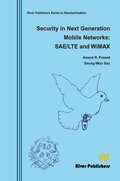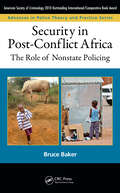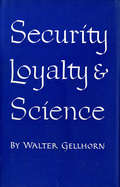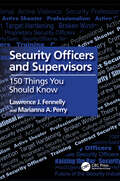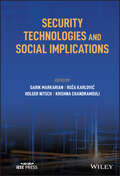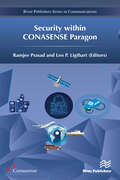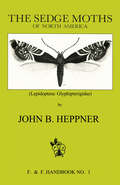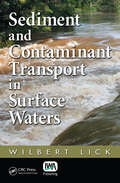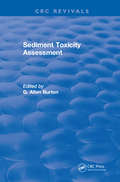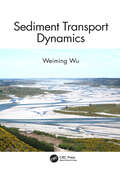- Table View
- List View
Securitizing Marine Protected Areas: Geopolitics, Environmental Justice, and Science (Earthscan Oceans)
by Elizabeth M. De SantoThis book presents a novel examination of Marine Protected Areas within a security context, bridging science, policy, and geopolitics, and addressing the often-under-emphasized aspect of environmental justice.The book argues that Marine Protected Areas (MPAs) are not only a critical tool for protecting marine biodiversity in a changing climate, but they also play an important role at the intersection of geopolitics and environmental justice, and they provide a case study of environmental governance at the science-policy interface. The book takes an interdisciplinary and critical approach and builds on the author's two decades of experience working in this field. Geopolitically, it explores the ways in which MPAs provide footprints for influence and access to resources far from home for nations with overseas territories. MPAs also raise important issues connected to equity, environmental justice, and social justice, including access to resources and participation in environmental decision-making processes, key aspects for achieving long-term conservation goals. The book also demonstrates how MPAs are a critical lens for understanding how policy makers cope with scientific uncertainty, and the necessity of well-designed and precautionary science advisory processes. While the ecological contribution of MPAs is paramount, social issues and geopolitical considerations are often less obvious in the discourse underpinning MPAs, and the resulting tensions can undermine long-term conservation objectives. By applying the three lenses of geopolitics, environmental justice and science, this book provides key insights to help the international community moving past the 2030 biodiversity targets and beyond, towards a future of meaningful, equitable, and effective conservation approaches.This book will be of great interest to students and scholars of biodiversity conservation, marine studies, political geography, environmental governance, and science-policy studies. It will also be of interest to marine conservation governance professionals and policymakers.
Security: An Introduction
by Philip P. PurpuraToday, threats to the security of an organization can come from a variety of sources- from outside espionage to disgruntled employees and internet risks to utility failure. Reflecting the diverse and specialized nature of the security industry, Security: An Introduction provides an up-to-date treatment of a topic that has become increasingly comple
Security and Conservation: The Politics of the Illegal Wildlife Trade
by Rosaleen DuffyAn exploration of the scale, practical reality, and future implications of the growing integration of biodiversity conservation with global security concerns &“There are few keener observers of international biodiversity conservation than Rosaleen Duffy. With a ferocity of purpose, she investigates the tenuous connection and nuances among illegal wildlife trade, terrorism threats, and national security.&”—Steven R. Brechin, Rutgers University, New Brunswick Debates regarding environmental security risks have generally focused on climate change and geopolitical water conflicts. Biodiversity conservation, however, is increasingly identified as a critical contributor to national and global security. The illegal wildlife trade is often articulated as a driver of biodiversity losses, and as a source of finance for organized crime networks, armed groups, and even terrorist networks. Conservationists, international organizations, and national governments have raised concerns about &“convergence&” of wildlife trafficking with other serious offenses, including theft, fraud, corruption, drugs and human trafficking, counterfeiting, firearms smuggling, and money laundering. In Security and Conservation, Rosaleen Duffy examines the scale, practical reality, and future implications of the growing integration of biodiversity conservation with global security concerns. Duffy takes a political ecology approach to develop a deeper understanding of how and why wildlife conservation turned toward security‑oriented approaches to tackle the illegal wildlife trade.
Security and Environmental Sustainability of Multimodal Transport
by Solmaz Haji Hosseinloo Michael Bell Urszula KanturskaThis book is the result of a NATO Advanced Research Workshop which was held at Imperial College London in January 2009. It features contributions from a range of international experts covering topics related to the transport of hazardous materials, such as routeing and scheduling, risk assessment, security, and social and environmental exposure. There is also a broad look at the implications of climate change for transport. This unique resource offers a deep understanding of hazardous material transportation and concomitant security and environmental problems. The risks involved in the transport of dangerous goods are shown to arise mainly from the location of the sources and destinations as well as the timing of deliveries. Environmental concerns, including the implications of climate change for transport, provide a useful context for the more analytical material. The book is timely and topical as the subjects covered have become a focus for public concern in recent years, due in part to terrorist attacks on transport systems. This comprehensive reference provides examples from around the world, illustrating the diversity of regulations which apply to the handling and transport of dangerous goods. It also provides interesting insights into the global energy supply chain and describes on-going work on establishing network vulnerability.
Security and Privacy for Implantable Medical Devices
by Wayne Burleson Sandro CarraraThis book presents a systematic approach to analyzing the challenging engineering problems posed by the need for security and privacy in implantable medical devices (IMD). It describes in detail new issues termed as lightweight security, due to the associated constraints on metrics such as available power, energy, computing ability, area, execution time, and memory requirements. Coverage includes vulnerabilities and defense across multiple levels, with basic abstractions of cryptographic services and primitives such as public key cryptography, block ciphers and digital signatures. Experts from Computer Security and Cryptography present new research which shows vulnerabilities in existing IMDs and proposes solutions. Experts from Privacy Technology and Policy will discuss the societal, legal and ethical challenges surrounding IMD security as well as technological solutions that build on the latest in Computer Science privacy research, as well as lightweight solutions appropriate for implementation in IMDs.
Security and Privacy in Biometrics
by Patrizio CampisiThis important text/reference presents the latest secure and privacy-compliant techniques in automatic human recognition. Featuring viewpoints from an international selection of experts in the field, the comprehensive coverage spans both theory and practical implementations, taking into consideration all ethical and legal issues. Topics and features: presents a unique focus on novel approaches and new architectures for unimodal and multimodal template protection; examines signal processing techniques in the encrypted domain, security and privacy leakage assessment, and aspects of standardization; describes real-world applications, from face and fingerprint-based user recognition, to biometrics-based electronic documents, and biometric systems employing smart cards; reviews the ethical implications of the ubiquity of biometrics in everyday life, and its impact on human dignity; provides guidance on best practices for the processing of biometric data within a legal framework.
Security and Privacy in Cyberspace (Blockchain Technologies)
by Omprakash Kaiwartya Keshav Kaushik Sachin Kumar Gupta Ashutosh Mishra Manoj KumarThis book highlights the literature and the practical aspects to understand cybersecurity and privacy in various networks and communication devices. It provides details of emerging technologies on various networks by protecting the privacy and security of cyberspace. This book presents state-of-the-art advances in the field of cryptography and network security, cybersecurity and privacy, providing a good reference for professionals and researchers.
Security and Resilience of Control Systems: Theory and Applications (Lecture Notes in Control and Information Sciences #489)
by Quanyan Zhu Hideaki IshiiThis book comprises a set of chapters that introduce various topics pertinent to novel approaches towards enhancing cyber-physical measures for increased security and resilience levels in control systems. The unifying theme of these approaches lies in the utilization of knowledge and models of the physical systems, rather than an attempt to reinvigorate conventional IT-based security measures.The contributing authors present perspectives on network security, game theory, and control, as well as views on how these disciplines can be combined to design resilient, safe, and secure control systems. The book explores how attacks in different forms, such as false data injections and denial-of-service can be very harmful, and may not be detected unless the security measures exploit the physical models. Several applications are discussed, power systems being considered most thoroughly. Because of its interdisciplinary nature—techniques from systems control, game theory, signal processing and computer science all make contributions—Security and Resilience of Control Systems will be of interest to academics, practitioners and graduate students with a broad spectrum of interests.
Security Architecture – How & Why (River Publishers Series In Security And Digital Forensics Ser.)
by Tom MadsenSecurity Architecture, or Enterprise Information security architecture, as it was originally coined by Gartner back in 2006, has been applied to many things and different areas, making a concrete definition of Security architecture a difficult proposition. But having an architecture for the cyber security needs of an organization is important for many reasons, not least because having an architecture makes working with cyber security a much easier job, since we can now build on a, hopefully, solid foundation. Developing a security architecture is a daunting job, for almost anyone, and in a company that has not had a cyber security program implemented before, the job becomes even harder. The benefits of having a concrete cyber security architecture in place cannot be overstated! The challenge here is that a security architecture is not something that can stand alone, it absolutely must be aligned with the business in which is being implemented.This book emphasizes the importance, and the benefits, of having a security architecture in place. The book will be aligned with most of the sub frameworks in the general framework called SABSA, or Sherwood Applied Business Security Architecture. SABSA is comprised of several individual frameworks and there are several certifications that you can take in SABSA. Aside from getting a validation of your skills, SABSA as a framework focusses on aligning the Security Architecture with the business and its strategy. Each of the chapters in this book will be aligned with one or more of the components in SABSA, the components will be described along with the introduction to each of the chapters.
Security Framework and Defense Mechanisms for IoT Reactive Jamming Attacks (Studies in Systems, Decision and Control #548)
by Alvaro Rocha Fadele Ayotunde AlabaThis book digs into the important confluence of cybersecurity and big data, providing insights into the ever-changing environment of cyber threats and solutions to protect these enormous databases. In the modern digital era, large amounts of data have evolved into the vital organs of businesses, providing the impetus for decision-making, creativity, and a competitive edge. Cyberattacks pose a persistent danger to this important resource since they can result in data breaches, financial losses, and harm to an organization's brand. Features of particular interest include: a. Understanding the Threat Landscape: The book gives a complete review of the many different types of cyber threats that target big data, including data breaches, ransomware attacks, and insider threats. b. Analysing Real-World Case Studies: The purpose of this section is to provide the reader with useful insights into the strategies, methods, and processes that cyber adversaries use via the in-depth examination of real-world assaults on big data. c. Strategies for Risk Mitigation: This book provides a comprehensive and actionable approach to reducing the dangers of cyberattacks on large amounts of data. It encompasses a broad variety of tactics, including network protection, encoding, and access restrictions d. Emerging Technologies: This section introduces readers to cutting-edge technologies and best practices for securing large data. e. Compliance with Regulations: The book examines the regulatory environment that governs data protection and privacy, including the General Data Protection Regulation (GDPR), the California Consumer Privacy Act (CCPA), and industry-specific requirements. f. Trends of the Future: This book covers current trends and issues in cybersecurity and gives forward-looking views into the future of big data security. This is done in recognition that the cybersecurity environment is always shifting and developing. g. Contributors of Expertise: The book includes contributions from industry practitioners, data scientists, and cybersecurity specialists who have hands-on experience defending large data settings.
Security in Computer and Information Sciences: Second International Symposium, EuroCybersec 2021, Nice, France, October 25–26, 2021, Revised Selected Papers (Communications in Computer and Information Science #1596)
by Erol Gelenbe Marija Jankovic Dionysios Kehagias Anna Marton Andras VilmosThis open access book constitutes the thoroughly refereed proceedings of the Second International Symposium on Computer and Information Sciences, EuroCybersec 2021, held in Nice, France, in October 2021.The 9 papers presented together with 1 invited paper were carefully reviewed and selected from 21 submissions. The papers focus on topics of security of distributed interconnected systems, software systems, Internet of Things, health informatics systems, energy systems, digital cities, digital economy, mobile networks, and the underlying physical and network infrastructures.This is an open access book.
Security in Next Generation Mobile Networks: SAE/LTE and Wimax (River Publishers Series In Standardisation Ser.)
by Anand R. Prasad Seung-Woo SeoStarting from voice services with simple terminals, today a mobile device is nothing sort of a small PC in the form of smart-phones. The result has been a huge increase in data-services giving mobile communication access to critical aspects of human society / life. This has led to standardization of SAE/LTE (System Architecture Evolution / Long Term Evolution) by 3GPP and IEEE 802.16e / WiMAX. Together with penetration of mobile communications and new standardization come new security issues and thus the need for new security solutions. This book provides a fresh look at those security aspects, with main focus on the latest security developments of 3GPP SAE/LTE and WiMAX. SAE/LTE is also known as Evolved Packet System (EPS).The intended audience for this book is mobile network and device architects, designers, researchers and students. The goal of the authors, who have a combined experience of more than 25 years in mobile security standardization, architecture, research, and education, is to provide the book?s readers with a fresh and up-to-date look at the architecture and challenges of EPS and WiMAX security.
Security in Post-Conflict Africa: The Role of Nonstate Policing (Advances in Police Theory and Practice)
by Bruce BakerPolicing is undergoing rapid change in Africa as a result of democratization, the commercialization of security, conflicts that disrupt policing services, and peace negotiations among former adversaries. These factors combined with the inability of Africa‘s state police to provide adequate protection have resulted in the continuing popularity of va
Security, Loyalty, and Science (Cornell Studies in Civil Liberties)
by Walter GellhornBoth sides of a sensitive problem are assessed by Professor Gellhorn in this penetrating analysis of national security and its effect upon scientific progress.The costs and advantages of secrecy in certain areas of science and the conflict between national safety and individual rights in the administration of our federal loyalty program are presented; all the arguments are objectively weighed. The book answers such questions as: Can young scientists be well trained when publication and teaching are not free? Have we gone far enough-or too far-in avoiding "security risks" in important scientific establishments? How does the federal drive against "potentially disloyal" persons actually work? Do "fear of the smear" and crude methods discourage public service by American scientists?This study, a unit of an investigation of control of subversive activities supported by grants from the Rockefeller Foundation, is based upon two years of research and numerous field interviews of scientists, administrators, defense officials, and educators. Security, Loyalty, and Science is a volume in the series Cornell Studies in Civil Liberty, of which Robert E. Cushman is advisory editor.
Security Manager's Guide to Disasters: Managing Through Emergencies, Violence, and Other Workplace Threats
by Anthony D. ManleyTerrorist or criminal attack, fire emergency, civil or geographic disruption, or major electrical failure recent years have witnessed an increase in the number of natural disasters and man-made events that have threatened the livelihoods of businesses and organizations worldwide. Security Manager‘s Guide to Disasters: Managing Through Emergencies,
Security Officers and Supervisors: 150 Things You Should Know
by Lawrence J. Fennelly Marianna A. PerrySecurity Officers and Supervisors: 150 Things You Should Know presents an array of relevant topics, including addressing “Tips of the Trade” in how to manage a team of professionals and serve as an effective supervisor. This includes both keeping management informed of decisions, aligning policy, procedure, and training with business objectives, and hiring and managing a team of professionals to maintain continuity of operations and a safe, secure environment. There are many factors involved in managing a department and workforce and the book uses a handy-reference format to present the salient information, both concrete knowledge as well as the softer skills, required for managers to motivate individuals and lead teams to pull in the same direction.Short, easy-to-read chapters include lists of relevant definitions, some do’s and don’ts, best practices, emerging trends, and well as example case studies based upon the authors’ professional experience. The primary goal is to provide a foundation for readers to identify, comprehend, and apply management concepts and security principles in their own environments so that readers will be readily prepared to troubleshoot problems and overcome challenges.Building and leading a trusted team that can set and achieve clearly outlined objectives begins with leadership. Security Officers and Supervisors: 150 Things You Should Know outlines those principles and traits required for professionals to succeed when promoted (though, more often than not, thrust!) into a security supervisory role.
Security Rights in Intellectual Property (Ius Comparatum - Global Studies in Comparative Law #45)
by Eva-Maria KieningerThis book discusses the main legal and economic challenges to the creation and enforcement of security rights in intellectual property and explores possible avenues of reform, such as more specific rules for security in IP rights and better coordination between intellectual property law and secured transactions law. In the context of business financing, intellectual property rights are still only reluctantly used as collateral, and on a small scale. If they are used at all, it is mostly done in the form of a floating charge or some other “all-asset” security right. The only sector in which security rights in intellectual property play a major role, at least in some jurisdictions, is the financing of movies. On the other hand, it is virtually undisputed that security rights in intellectual property could be economically valuable, or even crucial, for small and medium-sized enterprises – especially for start-ups, which are often very innovative and creative, but have limited access to corporate financing and must rely on capital markets (securitization, capital market). Therefore, they need to secure bank loans, yet lack their own traditional collateral, such as land.
Security Technologies and Social Implications
by Garik Markarian Ru A Karlovi Holger Nitsch Krishna ChandramouliB>SECURITY TECHNOLOGIES AND SOCIAL IMPLICATIONS Explains how the latest technologies can advance policing and security, identify threats, and defend citizens from crime and terrorism Security Technologies and Social Implications focuses on the development and application of new technologies that police and homeland security officers can leverage as a tool for both predictive and intelligence-led investigations. The book recommends the best practices for incorporation of these technologies into day-to-day activities by law enforcement agencies and counter-terrorism units. Practically, it addresses legal, technological, and organizational challenges (e.g. resource limitation and privacy concerns) combined with challenges related to the adoption of innovative technologies. In contrast to classic tools, modern policing and security requires the development and implementation of new technologies using AI, machine learning, social media tracking, drones, robots, GIS, computer vision, and more. As crime (and cybercrime in particular) becomes more and more sophisticated, security requires a complex mix of social measures, including prevention, detection, investigation, and prosecution. Key topics related to these developments and their implementations covered in Security Technologies and Social Implications include: New security technologies and how these technologies can be implemented in practice, plus associated social, ethical or policy issues Expertise and commentary from individuals developing and testing new technologies and individuals using the technologies within their everyday roles The latest advancements in commercial and professional law enforcement technologies and platforms Commentary on how technologies can advance humanity by making policing and security more efficient and keeping citizens safe Security Technologies and Social Implications serves as a comprehensive resource for defense personnel and law enforcement staff, practical security engineers, and trainee staff in security and police colleges to understand the latest security technologies, with a critical look at their uses and limitations regarding potential ethical, regulatory, or legal issues.
Security within CONASENSE Paragon
by Ramjee Prasad Leo P. LigthartSecurity within CONASENSE Paragon describes in particular the cyber security issues in the field of Communication, Navigation, Sensing and Services within the broad platform of CTIF Global Capsule (CGC). This covers future technologies and its enablers, smart cities, crowd computing, reliable and secure communication interface, satellite unnamed air vehicles, wireless sensor networks, data analytics and deep learning, remotely piloted aircraft system and public safety, network neutrality, business ecosystem innovation and so on.
Sedentary Behaviour Epidemiology (Springer Series on Epidemiology and Public Health)
by Michael F. Leitzmann Carmen Jochem Daniela SchmidThis book addresses the origins, determinants and magnitude of the global problem of sedentary behaviour, along with concise yet in-depth solutions for tackling it. As a consequence of major technological advances in modern society, many people find themselves in environments characterized by prolonged sedentary behaviour. Building on the contributions of leading experts in the field, the new edition of this book presents updated knowledge about sedentary behaviour, its medical and public health significance, its correlates and determinants, measurement techniques, and recommendations for addressing this behaviour at the individual, community, environmental, and policy level. The book encompasses current research linking the COVID-19 pandemic to increased levels of sedentary behavior, and it covers global and planetary health aspects of sedentary behavior, highlighting sustainable development goals such as health and well-being for all. Applying a cross-disciplinary methodology, the book avoids considering physical activity and sedentary behavior as a single continuum, which potentially hampers progress in confronting widespread levels of sedentariness. Rather, the book helps readers better understand how sedentary and physically active behavior co-occur and how the two behaviours have distinct contributing factors. Building on the contributions of distinguished international experts in the field, this thorough resource is a valuable asset and challenges professionals, researchers, students, and practitioners alike to adopt new strategies and expand their reach.
Sedge Moths of North America: The (Lepidoptera Glyphipterigidae)
by John B. HeppnerRepresents the first comprehensive study of these moths in North America north of Mexico using modern systematic procedures involving assessment of a number of morphological and biological characters in relation to their phylogenetic status. This study also represents a worldwide generic study made in conjunction with the revision of the North American species, primarily to ascertain realistic generic limits and the placement of the various genera once included in the heterogeneous concept of the family. Extralimital genera are noted in a catalog of generic names associated with the Glyphipterigidae.
Sediment and Contaminant Transport in Surface Waters
by Wilbert LickContaminated bottom sediments and their negative impacts on water quality are a major problem in surface waters throughout the United States as well as in many other parts of the world. Even after elimination of the primary contaminant sources, these bottom sediments will be a main source of contaminants for many years to come. In order to determin
Sediment Toxicity Assessment
by G.Allen BurtonSediment Toxicity Assessment provides the latest information regarding how to evaluate sediment contamination and its effects on aquatic ecosystems. It presents an integrated ecosystem approach by detailing effective assessment methods, considerations, and effects to each major component of marine and freshwater systems, including the benthos, plankton, and fish communities. The approaches emphasize defining habitat conditions (physical and chemical), toxicant bioavailability, factors influencing toxicity (lab and field), biomarkers, acute and chronic toxicity, study design, collection methods, and EPA management strategies. The book also explains how to integrate the assessments.Sediment Toxicity Assessment will be useful to to all environmental managers, environmental scientists, ecotoxicologists, environmental regulators, aquatic ecologists, environmental contractors and consultants, instructors, students, conservation commissions, and environmental activist organizations.
Sediment Transport and Morphodynamics Modelling for Coasts and Shallow Environments
by Vanesa MagarThis reference for engineers, and graduate students covers sediment transport and morphodynamics modelling in nearshore environments. It presents the fundamentals required for understanding the physics and for setting up numerical models. This book covers hydrodynamics of estuarine and coastal environments, properties of seafloor and estuarine composition, and hydroenvironmental interactions; emphasising the inter-relations of small- and large-scale processes, and short- and large-evolution timescales. The focus is, principally, on the application of shallow-water theory, but some surface wave models, and coupling of shallow-water models with surface waves is also discussed to some extent. The guidance on running regional models and the case studies presented are directed to managed realignment, coastal protection, climate change impacts, and offshore renewables. Key features: Gives a balanced review of this rich interdisciplinary area Bridges practical engineering and research Offers both large- and small-scale application Suits graduate students and researchers as well as consulting engineers Vanesa Magar is a senior researcher and associate professor at the Centro de Investigación Científica y de Educación Superior de Ensenada (CICESE) in Baja California, Mexico. She was formerly a researcher and then a lecturer at Plymouth University, UK.
Sediment Transport Dynamics
by Weiming WuThis book focuses on the fundamentals of sediment transport in surface waters. It covers sediment properties, open channel flows, sediment particle settling, incipient motion, bed forms, bed load, suspended load, total load, cohesive sediments, water-sediment two-phase flows, hyperconcentrated flows, debris flows, wave-induced sediment transport, turbidity currents, and physical modeling. Besides the primary context of river sedimentation, this book extensively covers sediment transport under coexisting waves and currents in coasts and estuaries, hyperconcentrated and debris flows in rivers, as well as turbidity currents in lakes, reservoirs, channels, and the ocean. It includes a chapter on the water-sediment two-phase flow theory, which is considered the basis of many sediment transport models. It introduces some special topics have that emerged in recent years, such as the transport of mixed cohesive and noncohesive sediments, biofilm-coated sediments, and infiltrated sand within gravel and cobble beds. The text merges classical and new knowledge of sediment transport from various sources in English and non-English literature and includes important contributions made by many scientists and engineers from all over the world. It balances the breadth, depth, fundamental importance, practical applicability, and future advancement of the covered knowledge, and can be used as a text and reference book. The chapters are arranged in a useful sequence for teaching purposes. Certain homework problems are prepared, which also highlight the important topics for instructors to select. Solutions to homework problems are available from the author by request.
